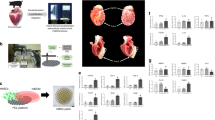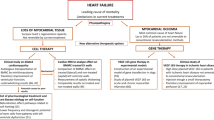Abstract
Clinical trials have begun to assess the feasibility, safety, and efficacy of administering progenitor cells to the heart in order to repair or perhaps reverse the effects of myocardial ischemia and injury. In contrast to surgical-based injections, which are often coupled with coronary bypass surgery, catheter-based injections are less invasive and make it possible to evaluate cell products used as sole interventions. The two methods that have been tested in humans are injecting cells directly into the ventricular wall with catheter systems dedicated to that purpose and infusing cells into coronary arteries with standard balloon angioplasty catheters. The catheters described in this article have been shown in both animal and clinical studies to be effective in cell delivery and to be safe. They are well-designed and user-friendly devices, but require further investigation to identify means for optimizing cell retention and to address other limitations. Randomized, placebo-controlled trials utilizing catheters for cell implantation are under way, and others are soon to follow. The results of these studies will help to shape the direction of future investigations, both clinical and basic. The spectrum of cardiac diseases, the variety of catheters for cell delivery, and the wide array of progenitor cell types open up this young field to creative discoveries.
This is a preview of subscription content, access via your institution
Access options
Subscribe to this journal
Receive 12 print issues and online access
$209.00 per year
only $17.42 per issue
Buy this article
- Purchase on Springer Link
- Instant access to full article PDF
Prices may be subject to local taxes which are calculated during checkout





Similar content being viewed by others
References
Marelli D et al. (1992) Cell transplantation for myocardial repair: an experimental approach. Cell Transplant 1: 383–390
Torella D et al. (2006) Resident human cardiac stem cells: role in cardiac cellular homeostasis and potential for myocardial regeneration. Nat Clin Pract Cardiovasc Med 3 (Suppl 1): S8–S13
Fraidenraich D and Benezra R (2006) Embryonic stem cells prevent developmental cardiac defects in mice. Nat Clin Pract Cardiovasc Med 3 (Suppl 1): S14–S17
Martens TP et al. (2006) Mesenchymal lineage precursor cells induce vascular network formation in ischemic myocardium. Nat Clin Pract Cardiovasc Med 3 (Suppl 1): S18–S22
Schächinger V et al. (2006) Bone-marrow-derived progenitor cell therapy in need of proof of concept: design of the REPAIR-AMI trial. Nat Clin Pract Cardiovasc Med 3 (Suppl 1): S23–S28
Fraser JK et al. (2006) Plasticity of human adipose stem cells towards endothelial cells and cardiomyocytes. Nat Clin Pract Cardiovasc Med 3 (Suppl 1): S33–S37
Siminiak T et al. (2006) Postinfarction heart failure: surgical and trans-coronary-venous transplantation of autologous myoblasts. Nat Clin Pract Cardiovasc Med 3 (Suppl 1): S46–S51
Bartunek J et al. (2006) Timing of intracoronary bone-marrow-derived stem-cell transplantation following ST-elevation MI. Nat Clin Pract Cardiovasc Med 3 (Suppl 1): S52–S56
Behfar A and Terzic A (2006) Derivation of a cardiopoietic population from human mesenchymal stem cells yields cardiac progeny. Nat Clin Pract Cardiovasc Med 3 (Suppl 1): S78–S82
Shintani S et al. (2006) Synergistic effect of combined intramyocardial CD34+ cells and VEGF2 gene therapy after myocardial infarction. Nat Clin Pract Cardiovasc Med 3 (Suppl 1): S123–S128
Smits PC et al. (2003) Catheter-based intramyocardial injection of autologous skeletal myoblasts as a primary treatment of ischemic heart failure: clinical experience with six-month follow-up. J Am Coll Cardiol 42: 2063–2069
Strauer BE et al. (2002) Repair of infarcted myocardium by autologous intracoronary mononuclear bone marrow cell transplantation in humans. Circulation 106: 1913–1918
Assmus B et al. (2002) Transplantation of progenitor cells and regeneration enhancement in acute myocardial infarction (TOPCARE-AMI). Circulation 106: 3009–3017
Wollert KC et al. (2004) Intracoronary autologous bone-marrow cell transfer after myocardial infarction: the BOOST randomised controlled clinical trial. Lancet 364: 141–148
Fernández-Avilés F et al. (2004) Experimental and clinical regenerative capability of human bone marrow cells after myocardial infarction. Circ Res 95: 742–748
Menasché P et al. (2003) Autologous skeletal myoblast transplantation for severe postinfarction left ventricular dysfunction. J Am Coll Cardiol 41: 1078–1083
Siminiak T et al. (2003) Myocardial replacement therapy. Circulation 108: 1167–1171
Taylor DA et al. (1998) Regenerating functional myocardium: improved performance after skeletal myoblast transplantation. Nat Med 4: 929–933
Menasché P et al. (2001) Myoblast transplantation for heart failure. Lancet 357: 279–280
Stamm C et al. (2003) Autologous bone-marrow stem-cell transplantation for myocardial regeneration. Lancet 361: 45–46
Sherman W (2003) Cellular therapy for chronic myocardial disease: nonsurgical approaches. Basic Appl Myol 13: 11–14
Grossman PM et al. (2002) Incomplete retention after direct myocardial injection. Catheter Cardiovasc Interv 55: 392–397
Opie SR and Dib N (2006) Surgical and catheter delivery of autologous myoblasts in patients with congestive heart failure. Nat Clin Pract Cardiovasc Med 3 (Suppl 1): S42–S45
Vale PR et al. (2000) Left ventricular electromechanical mapping to assess efficacy of phVEGF(165) gene transfer for therapeutic angiogenesis in chronic myocardial ischemia. Circulation 102: 965–974
Losordo DW et al. (1998) Gene therapy for myocardial angiogenesis: initial clinical results with direct myocardial injection of phVEGF165 as sole therapy for myocardial ischemia. Circulation 98: 2800–2804
Asahara T et al. (1997) Isolation of putative progenitor endothelial cells for angiogenesis. Science 275: 964–967
Shintani S et al. (2001) Mobilization of endothelial progenitor cells in patients with acute myocardial infarction. Circulation 103: 2776–2779
Kocher AA et al. (2001) Neovascularization of ischemic myocardium by human bone-marrow-derived angioblasts prevents cardiomyocyte apoptosis, reduces remodeling and improves cardiac function. Nat Med 7: 430–436
Losordo DW and Dimmeler S (2004) Therapeutic angiogenesis and vasculogenesis for ischemic disease: part II: cell-based therapies. Circulation 109: 2692–2697
Leon MB et al. (2005) A blinded, randomized, placebo-controlled trial of percutaneous laser myocardial revascularization to improve angina symptoms in patients with severe coronary disease. J Am Coll Cardiol 46: 1812–1819
Vulliet PR et al. (2004) Intra-coronary arterial injection of mesenchymal stromal cells and microinfarction in dogs. Lancet 363: 783–784
Hou D et al. (2005) Radiolabeled cell distribution after intramyocardial, intracoronary, and interstitial retrograde coronary venous delivery: implications for current clinical trials. Circulation 112 (Suppl 9): I-150–I-156
Smits PC et al. (2002) Efficacy of percutaneous intramyocardial injections using a nonfluoroscopic 3-D mapping based catheter system. Cardiovasc Drugs Ther 16: 527–533
Hill JM et al. (2003) Serial cardiac magnetic resonance imaging of injected mesenchymal stem cells. Circulation 108: 1009–1014
Christman KL et al. (2004) Injectable fibrin scaffold improves cell transplant survival, reduces infarct expansion, and induces neovasculature formation in ischemic myocardium. J Am Coll Cardiol 44: 654–660
Naimark WA et al. (2003) Adenovirus-catheter compatibility increases gene expression after delivery to porcine myocardium. Hum Gene Ther 14: 161–166
Marshall DJ et al. (2000) Biocompatibility of cardiovascular gene delivery catheters with adenovirus vectors: an important determinant of the efficiency of cardiovascular gene transfer. Mol Ther 1: 423–429
Corti R et al. (2005) Real time magnetic resonance guided endomyocardial local delivery. Heart 91: 348–353
Fearon WF et al. (2004) Evaluation of high-pressure retrograde coronary venous delivery of FGF-2 protein. Catheter Cardiovasc Interv 61: 422–428
Ikeno F et al. (2004) Novel percutaneous adventitial drug delivery system for regional vascular treatment. Catheter Cardiovasc Interv 63: 222–230
Bartunek J et al. (2005) Intracoronary injection of CD133-positive enriched bone marrow progenitor cells promotes cardiac recovery after recent myocardial infarction: feasibility and safety. Circulation 112 (Suppl 9): I-178–I-183
Acknowledgements
We are grateful to V Fuster, of the Zena and Michael A Wiener Cardiovascular Institute and the Marie-Josée and Henry R Kravis Center for Cardiovascular Health, Mount Sinai School of Medicine, New York, NY, USA, and to MB Leon, of the Cardiovascular Research Foundation and of the Center for Interventional Vascular Therapy, Columbia University Medical Center, for their guidance in preparing this paper.
Author information
Authors and Affiliations
Corresponding author
Ethics declarations
Competing interests
The authors declare no competing financial interests.
Rights and permissions
About this article
Cite this article
Sherman, W., Martens, T., Viles-Gonzalez, J. et al. Catheter-based delivery of cells to the heart. Nat Rev Cardiol 3 (Suppl 1), S57–S64 (2006). https://doi.org/10.1038/ncpcardio0446
Received:
Accepted:
Issue Date:
DOI: https://doi.org/10.1038/ncpcardio0446
This article is cited by
-
Advancing stem cell therapy from bench to bedside: lessons from drug therapies
Journal of Translational Medicine (2014)
-
Impact of Balloon Inflation Pressure on Cell Viability with Single and Multi Lumen Catheters
Journal of Cardiovascular Translational Research (2014)



